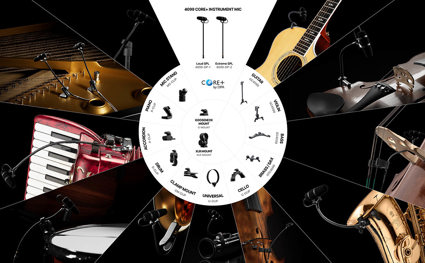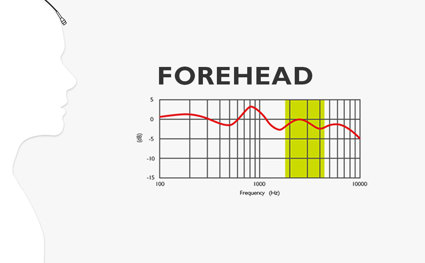10 points on close miking for live performances
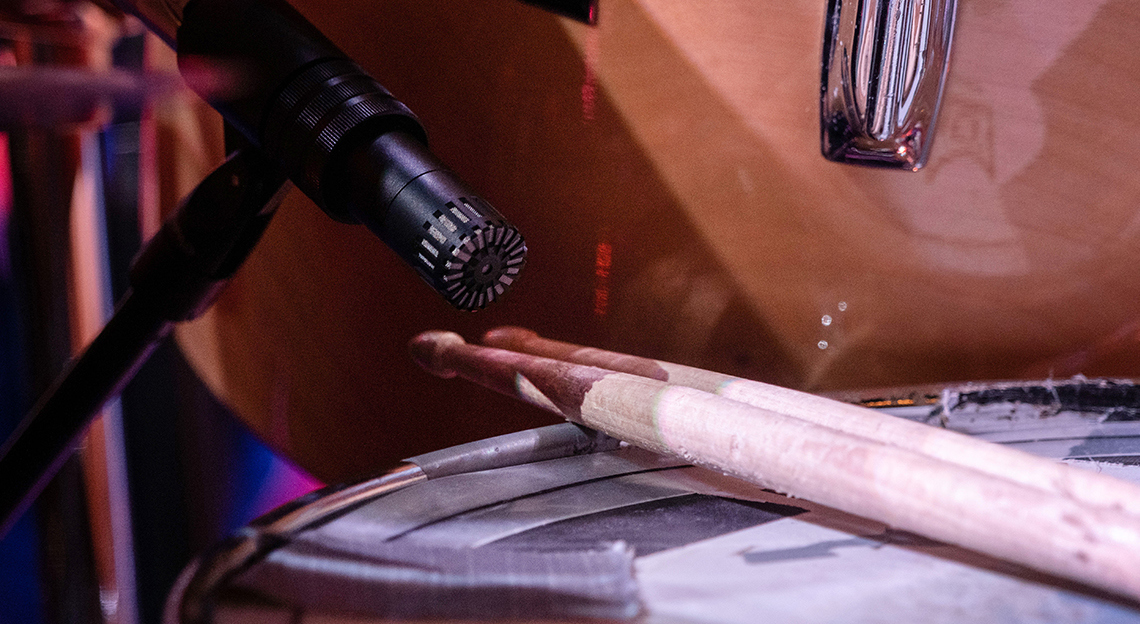
What is close miking & why use it?
Close-miking is the term we use when we place a microphone close to the sound source, for instance, a musical instrument. However, there is more to it than that. Often, the distance between the microphone and the sound source is shorter than the normal listening distance of that source. This may change the perception of what the source sounds like. In the case of a musical instrument, this also implies a microphone position so close that we do not get the sound of that instrument to the full extent. Sometimes this is fine because we just want to pick up some characteristical sounds. In other cases, we wish for the full sonic image of the instrument.
We apply close-miking to obtain the highest possible sound pressure level (SPL) of the sound source – and the lowest SPL of all other nearby or distant sources. Close-miking can provide us with the possibility of a cleaner mix. Furthermore, close-miking can reduce the risk of acoustical feedback when used with public address systems (PA) as less gain of the microphone is needed being so close.
Error loading Partial View script (file: ~/Views/MacroPartials/TaggedProducts.cshtml)
Recording or PA?
The selection of microphones is traditionally related to the application they are being used for. It is very common that engineers choose one type of microphone for recording and another for amplification of the same instrument. If possible, selecting one microphone that serves both purposes is a good idea.
For recording, we often prefer microphones that need little or no equalization. It is all about the sound, the timbre and the transparency of the instrument. For PA, it is often a question of getting as much sound as possible, leaving us with a wide and stable feedback margin.
When the two demands meet in the same microphone everybody is happy. But do not take it for granted.
DPA Microphones has designed a range of microphones that are equally valid for recording and reinforcement:
Instrument Microphones
Miniature Microphones
Recording Microphones
Listen to the sound source
Too often microphones are selected and positioned based on past experiences and industry tradition. The microphone is selected and placed in a specific position in front of the instrument just because this is the way everyone else is doing it.
Do yourself a favor and instead of bowing to tradition, listen to the instruments requiring close-miking. Listen with your ears close to – and move around – the individual instrument.
Then select a microphone and do the same. Listen through headphones while “sweeping” the microphone across the surface, the strings, the bell, the rim, the body of the instrument. Pick another microphone and repeat the procedure. If it is a directional microphone, check the sound by turning your microphone to both on-axis and off-axis positions.
By doing this, you will hear that each and every instrument has a unique sound. No two cellos, flutes, saxophones, kick drums, etc. sound the same. There may exist alternative microphone positions for each individual instrument.
Although you are a trained engineer, it is important for you to balance your experience and knowledge with respect for the sound of the musicians and the instruments. Make sure you listen well and choose the best microphone and placement for the job. This will lead to the best-sounding solution as well as the best working environment.
What is the sound field like?
Sound sources can be complex, especially in the near field. Some parts of a musical instrument may act like a point source. Others may act like line sources or plane sources. This is why the perceived sound, the timbre, may change a lot when moving the microphone in the near field of a musical instrument. The level of the point source drops with 6 dB per doubling of the distance. Line sources drop with 3 dB and plane sources do not drop at all! At a distance (a few meters away) the instrument eventually becomes a point source but close-up, many theoretical models are possible. This is why it is important to listen to the instrument before attaching microphones.
In practice, it is also a question of the behavior of the sound field of more distant sources.
How loud is it?
When selecting a microphone for close-miking, make sure that the microphone matches the SPL of the instrument. Is it a loud or soft sound source? Be aware that loud peaks or transients can easily reach 20 dB (10 times!) above the average-level.
The microphones’ dynamic range should always match the SPL of the source. If the source’s SPL is too high for the microphone (and the following chain), the signal gets distorted and eventually clips. If the source SPL is too soft for the microphone, the signal will get infected by the self noise created from the microphone itself. DPA microphones will deliver the high SPL of loud instruments which may then clip the signal – or more likely the preamplifier, or wireless transmitter, so make sure the rest of the audio chain also handles the high SPL. There is no cure once the signal has clipped, so avoid it. If you are in doubt how loud the sound source is, or will be, use a microphone that accepts a higher SPL.
Reflecting surfaces
One of the main purposes of applying close-miking is to get rid of other sources. However, we sometimes forget that even reflections may act as additional and unwanted sources.
If you choose a directional microphone, you should direct it at the primary sound source. Also, you should “point” the deaf angles at the unwanted sources. However, it is of no use if the primary source (or other obstacles) reflect the unwanted sound source back into the microphone. Then the unwanted source is captured as well. This phenomenon is sometimes what happens when placing microphones in front of large-body instruments or speaker cabinets.
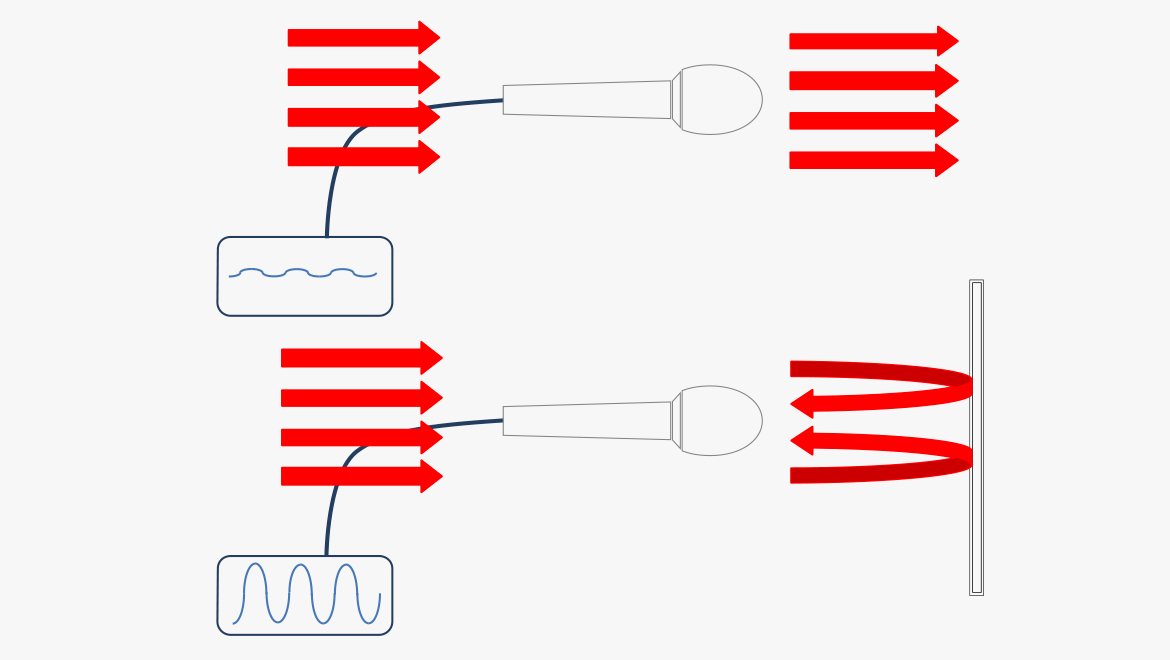
The microphone is oriented so the sound source is in the “deaf” direction. However, as soon as a reflective object is placed in front of the microphone, the unwanted source is reflected back to the microphone.
Also, the reflections can be a source of comb-filtering (see point 9), by adding the sound to itself after a small delay.
Microphone behavior – directivity
Directional microphones (like cardioids and supercardioids) are supposed to accept sound on-axis and gradually reject sound as the microphone is turned and the sound hits off-axis.
However, two different brands of microphones with the same directional pattern, like two cardioids or two supercardioids may sound very different even though the naming indicates they are quite alike.
As the off-axis sound may be an essential part of the desired sound, the off-axis smoothness of the microphone is vital. When choosing a microphone, listen to the off-axis sound. Microphones from DPA Microphones are extremely well-behaved in that matter.
Error loading Partial View script (file: ~/Views/MacroPartials/TaggedProducts.cshtml)The art of balancing the sound is also the art of placing and pointing the microphone. For instance, using a supercardioid microphone (like 4099 Instrument Microphone) to pick up the sound of an acoustic guitar, the microphone can be placed around the 12th fret and pointed in the direction of the sound hole. Another option is to position it closer to the sound hole and point it toward the fret. There are also multiple other positioning possibilities in between these two as well.
Working with both on-axis and off-axis characteristics of the microphone is a part of creating the right sound for your specific situation.
Microphone behaviour – proximity
All directional microphones (pressure gradient) have proximity effect. This means that the low frequency response of the mic changes with the distance from the sound source. Omnidirectional microphones (pressure microphones) don’t have this effect.
A directional microphone always has a specific distance at which the bass response is flat or neutral. When you move closer to the sound source than that point, the low frequencies will increase, when you get further away the low frequencies will decrease. The distance where the microphone is neutral can be adjusted to fit the intended use of the microphone.
This is why some recording microphones (for instance the Recording Microphone series) are designed to be used at a distance from the sound source. Other microphones (for example the d:facto™ Handheld Microphones and 4099 Instrument Microphones) are designed to pick up sound close to the sound source.
Also, the proximity effect can be used as an acoustic “low frequency equalizer.” Getting closer = getting more low end. Getting further away = getting less low end.
Comb-filtering
The filtering that arises when a signal is added to itself after having been delayed in time is called a comb filter. The resulting frequency response resembles a comb, hence the name. Comb filtering is rarely intentional, but it is heard all the time in sound productions, where it can arise both acoustically and electrically.
Acoustically, a typical occurance is when the sound on its way from the source to recipient (the microphone) takes in part a direct path and in part an indirect path - via a single reflective surface. The same sound is then received by the microphone more than once with a short delay between which creates the comb filtering.
In order for this delay to not affect the sound field at the microphone position, the reflection must be attenuated by at least 10 dB (reduced to one-third) and preferably 15 dB (one-fifth).
Electrically, the phenomenon arises when two microphones with a certain distance between them capture the same signal and the level from each microphone is of the same order of magnitude.
To avoid comb filtering when placing microphones, the distance to neighboring microphones should be at least three times longer than the distance of the source to the primary microphone. It also helps if the microphones are directional and pointing in opposite directions.
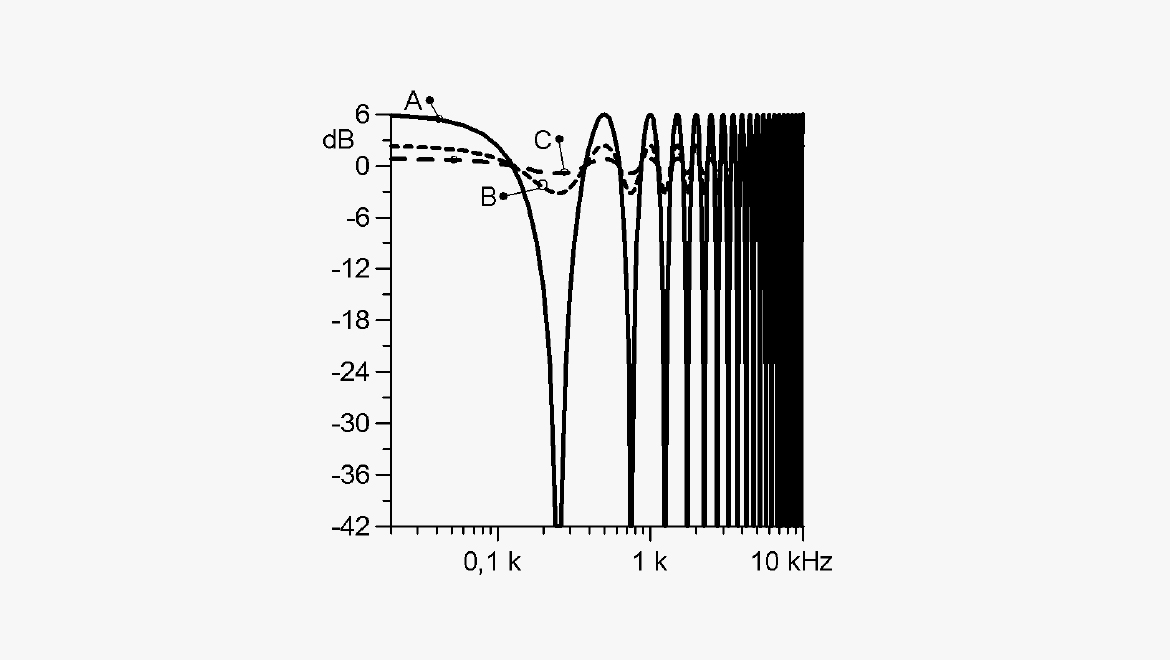
Three degrees of comb filtering are shown - curves A, B and C. Two signals from the same source are summed. The delay between the two signals is 2 ms. (which acoustically corresponds to a difference of path length of approximately 66 cm (26 in). The deepest cut in the frequency response (Curve A) occurs when the level of the direct signal and the delayed signal is exactly the same. Curves B and C correspond to a level difference of 10 dB and 15 dB respectively.
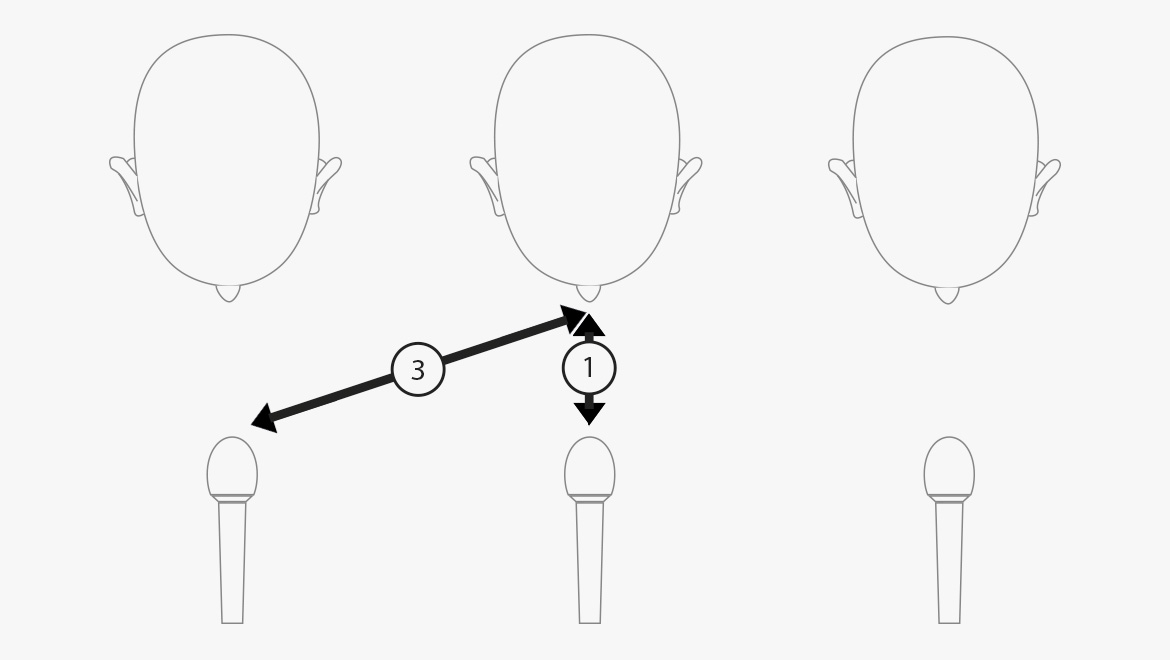
The 1:3 rule: The distance to neighboring microphones should be at least three times longer than the distance of the source to the primary microphone. Using directional microphones reduces the secondary signals further.
Mounts / holders
10. Mounts / holders
Close-miking often means attaching the microphone to the sound source. For this purpose, dedicated mounts or holders are needed. The basic requirements for these are:
• To permit optimum positioning of the microphone
• To keep the microphone in a fixed position despite handling of the instrument
• To avoid transmission of vibrations (from handling, instruments’ mechanical parts, etc.)
• To eliminate self-noise (rattling, resonances, squeaks, etc.)
• Easy, nondestructive mounting and removal
• Robust and highly-durable components
• Unobtrusive, small size and light weight
• Easy storage of the components when not in use
DPA Microphones has developed an exceptional range of fittings and holders to make mounting easy and efficient. The clip / mount range covers the vast majority of acoustical instruments.
